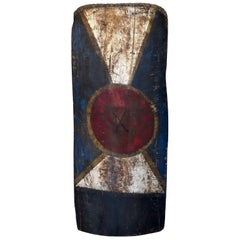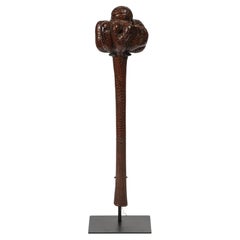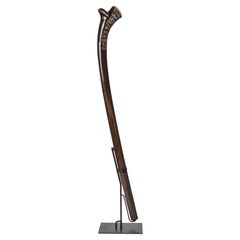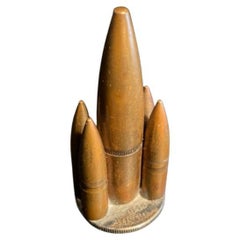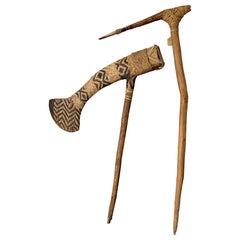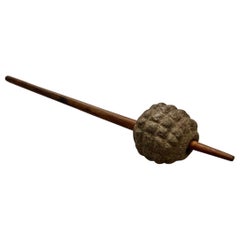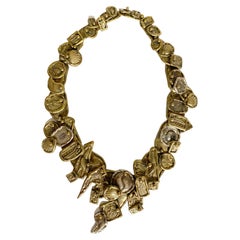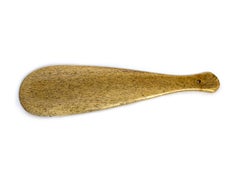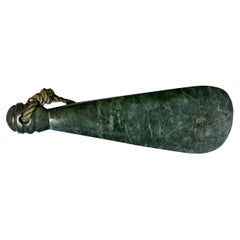Oceanic Arms, Armor and Weapons
to
3
3
8
1
2
1
5
3
2
6
3
3
3
2
3,186
180
77
54
52
8
8
8
Place of Origin: Oceanic
Early 20th Century Shield, Wahgi Valley, Western Highlands, Papua New Guinea
Located in Point Richmond, CA
Early 20th Century Shield, Wahgi Valley, Western Highlands, Papua New Guinea
This large, post contact, shield is traditionally decorated in bold colors with a central circle. This ...
Category
Early 20th Century Other Oceanic Arms, Armor and Weapons
Materials
Enamel, Wire
18th Century Polynesian Hardwood Ula Tavatava or Throwing War Club from Fiji
Located in Amsterdam, NL
A Polynesian hardwood Ula tavatava or throwing war club
Fiji, probably 18th century
All-over decorated in incised pattern, the bulbous top seems to have a stone grown into it.
H. 42 cm
Including museum-quality powder-coated stand.
Provenance:
Private collection, France
Polynesian culture is traditionally a culture of power and prestige, and there was a fine line between battle and ceremony. Warrior people par excellence, the Fijians had at their disposal a large panoply of weapons, each for a specific use.
The elegant Gata are called gun-sticks by Europeans due to the recognizable form. However, they are designed after a snake, gata in Fijian language. The Ula throwing clubs...
Category
18th Century Antique Oceanic Arms, Armor and Weapons
Materials
Hardwood
18th Century Polynesian Ironwood Gata Waka or War Club from Fiji
Located in Amsterdam, NL
A Polynesian ironwood Gata waka or war club
Fiji, probably 18th century or earlier
Measures: Height. 97 cm
Including museum-quality powder-coated stand.
Provenance:
Private collection, France
Polynesian culture is traditionally a culture of power and prestige, and there was a fine line between battle and ceremony. Warrior people par excellence, the Fijians had at their disposal a large panoply of weapons, each for a specific use.
The elegant Gata are called gun-sticks by Europeans due to the recognizable form. However, they are designed after a snake, gata in Fijian language. The Ula throwing clubs...
Category
18th Century Antique Oceanic Arms, Armor and Weapons
Materials
Hardwood
Trench Art Copper Bullet Paperweight 1944 Australia Sterling Silver Florin
Located in Stamford, CT
World War II trench art paperweight with five copper bullets, one large caliber, four smaller caliber mounted on an Australian Sterling Silver Florin.
Showing the portrait of King George...
Category
Mid-20th Century Mid-Century Modern Oceanic Arms, Armor and Weapons
Materials
Sterling Silver, Copper
Two Ceremonial Weapon from Highlands of Papua New Guinea Provenance
Located in Atlanta, GA
Two Oceanic ceremonial weapons from PNG highlands circa 20th century. It consists of two pieces. The first is an ax with a wood shaft and a flat elongated he...
Category
Mid-20th Century Tribal Oceanic Arms, Armor and Weapons
Materials
Rattan, Wood
19th Century Kukukuku Club from Highlands Papua
Located in NICE, FR
This rare antique Kukukuku (pronounced "cookah-cookah") war club is from the remote highlands of Papua New Guinea. It features a head made of stone in the characteristic 'pineapple' ...
Category
19th Century Tribal Antique Oceanic Arms, Armor and Weapons
Materials
Stone
A Rare Papua New Guinea Kukukuku War Club, Eastern Highlands - Morobe Province
Located in Ottawa, Ontario
This rare antique Kukukuku (pronounced "cookah-cookah") war club originates from the Morobe Province, which is a very remote area located within the Eastern Highlands of Papua New Gu...
Category
Early 20th Century Tribal Oceanic Arms, Armor and Weapons
Materials
Stone
A Rare Papua New Guinea Kukukuku 'Pineapple' Stone War Club, Eastern Highlands
Located in Ottawa, Ontario
This rare antique Kukukuku (pronounced "cookah-cookah") war club is from the remote Morobe Province located within the Eastern Highlands of Papua New Guinea.
The head is carved from...
Category
Early 20th Century Tribal Oceanic Arms, Armor and Weapons
Materials
Stone
Related Items
Vintage Pal Kepenyes Bronze/Brass Necklace, 20th Century
By Pal Kepenyes
Located in Point Richmond, CA
Vintage Pal Kepenyes bronze/brass necklace, 20th century.
This Hungarian born artist worked in Mexico for decades, known for free-form sculptural jewelry...
Category
20th Century Modern Oceanic Arms, Armor and Weapons
Materials
Brass, Bronze
$760 Sale Price
20% Off
H 19.5 in W 3.5 in D 0.5 in
Art Deco Leather and Sterling Silver Cigarette / Cigar Case
Located in Buenos Aires, Olivos
Exquisite leather cigar case with sterling silver collar. Expands for differing lengths of small cigar or cigarettes.
Made in the U.K. in the 1900-1920´s. It has the stamp of the re...
Category
Early 20th Century Art Deco Oceanic Arms, Armor and Weapons
Materials
Sterling Silver
$1,200 Sale Price
20% Off
H 3.55 in W 3.15 in D 0.63 in
Mid-20th Century Tribal Tapa Cloth, Fiji
Located in Point Richmond, CA
Tapa cloth made from mulberry fiber with natural pigments, Fiji, mid-20th century.
Category
Mid-20th Century Tribal Oceanic Arms, Armor and Weapons
Materials
Natural Fiber
Art Deco Sterling Silver Cigarette Cigarette Case - Goldsmiths & Silversmiths
By Goldsmiths & Silversmiths Co. Ltd.
Located in New York, NY
Art Deco Period, sterling silver, hinged cigarette case, London, year-hallmarked for 1931, Goldsmiths and Silversmiths (located at 112 Regent Street West, London) - makers. The cigar...
Category
1930s Art Deco Vintage Oceanic Arms, Armor and Weapons
Materials
Sterling Silver
$875
H 3.5 in W 3 in D 0.25 in
Early 20th Century Zebra Handmade Taxidermy Figurine
Located in Grythyttan, SE
MAKER: Unknown
COUNTRY: Unknown, could be Austria
PRODUCED: probably sometime between 1920-1960
EYES: Black, Glass
MATERIAL: Animal fur, probably goat.
SIZE: Height: 20 cm, Leng...
Category
Early 20th Century Other Oceanic Arms, Armor and Weapons
Materials
Animal Skin
W & M Sterling Silver Navajo Turquoise Ring
By Navajo
Located in Chula Vista, CA
Stunning Sterling Silver W & M Turquoise Ring
.75 diameter x .5 W
size 8
Preowned vintage condition
Refer to images
Category
Mid-20th Century Mid-Century Modern Oceanic Arms, Armor and Weapons
Materials
Stone, Sterling Silver
Antique Greek Pair of Silk/Metal Thread Embroideries, 18th Century
Located in San Francisco, CA
Antique Greek Pair Silk/Metal Thread Embroideries, 18th Century
Additional Information:
Dimensions: 0'11" L x 0'6" W
Origin: Greece
Period: 18th Cen...
Category
18th Century Antique Oceanic Arms, Armor and Weapons
Materials
Metal
Early 20th Century Stone Disc
Located in Vosselaar, BE
A polished hardstone disc. Provenance unknown but probably a early 20th century Hawaiin Ulu Maika stoen. Ulu Maika is a ancient game simular to bowling played by the indigineaous Haw...
Category
Early 20th Century Oceanic Arms, Armor and Weapons
Materials
Stone
Mud Cloth 'Bogolanfini', Mali, Bamana People, Mid-20th Century
Located in Ottawa, Ontario
A mud cloth (Bogolanfini),
Mali, Bamana People
mid-20th century.
Hand woven 'discharge dyed' cotton
Approximately 71 x 52 in. (180cm. x 132cm.)
A dazzling geometric pattern...
Category
Mid-20th Century Tribal Oceanic Arms, Armor and Weapons
Materials
Fabric
Antique Ethnic Artifact Sepik River Cassowary Bone from Papua New Guinea
Located in North Hollywood, CA
Antique Ethnic Artifact Sepik River Cassowary Bone from Papua New Guinea
For many groups in Papua New Guinea, bone was an important medium for making tools of all types. This artifact is made from leg bone of a cassowary, a large, flightless, and extremely dangerous, bird.
Cassowaries also play an important role in the mythology of groups in the Sepik River area.
Though no longer used these bone artifacts are still used ceremonially. They often play important roles in male initiation and other rituals. They are also worn as personal adornment by tucking them into a band of braided fibers worn around the upper arm.
Antique Ethnic Bone Cassowary Artifact with minimal carving and incised design confined to the joint end.
A small hole has been drilled through from both sides of the top and presumably for the threading of a cord.
The bone has been partially divided near the top and to form two prongs that project down the back of the dagger possibly allowing the user to wear is tuck into a waist band or belt.
Origin Papua New Guinea Maprik Dist Area
From the Art Collection of Marian and John Scott, acquired in 1962.
Similar items are in display in the Timothy S. Y. Lam Museum of Anthropology.
Purchased from the amazing private collection of Mark Lissauer who spent his life collecting niche ethnographic pieces.
About Mark Lissauer:
Mark Lissauer spent forty years travelling abroad for months at a time collecting ethnographic artefacts primarily from New Guinea and the islands of the West Pacific, and from Asia and Himalayan countries. Fluent in five languages and having in the course of business travelled to more than forty countries, Mark is well-known to museums and art-collectors around the world for his long career and his interesting and diverse collection of rare ethnographic material.
Mark knows the origin and symbolism of each piece. Through extensive research and more than ninety trips around the globe, Mark familiarised himself with the traditions of the various cultures he visited in order to understand the meaning of each object to its region and tribe. His home has a specialist library and several rooms are filled with tribal carvings, textiles and ethnographica.
He acquired his first tribal piece in 1948 during a business trip to Milne Bay, New Guinea, and has since documented the acquisition of some 35,000 items. Several thousands of these have been sold to important private collections and museums worldwide, including the Rockefeller Museum, the British Museum and the Musée National des Arts d’Afrique et d’Océanie, now incorporated into the Louvre Museum.
Estimator certificate of authenticity by Wayne Heathcote Tribal Art Dealer and Expert.
Heathcote has a flash gallery in Brussels, where much of the tribal art business is centred, and is an expert at Sotheby's tribal art sale...
Category
Early 20th Century Folk Art Oceanic Arms, Armor and Weapons
Materials
Bone
$650
H 1.25 in W 7.5 in D 1.5 in
Antique Ethnic Brass Traditional Anklet Bracelet from India Vide Poche
Located in North Hollywood, CA
Dhokra art old ethnic tribal brass traditional ankle bracelet from India, repurposed as ashtrays ,catchall, or vide poche.
Handcrafted of a hollow band of heavy brass decorated with chevron repoussé banding and lost wax granulation.
The brass inner plate was later added to use the bracelet as a small ashtray.
The closure was a push pin mechanism that was closed.
India, circa 1920s.
Measure: 7"5 D x 2" H.
"Dhokra is an ancient folk art tradition prevalent in India in the eastern states of West Bengal, Odisha, Jharkhand and Chhattisgarh. Dhokra craft objects are made through the process of non-ferrous metal casting using the lost-wax casting technique, which is one of the earliest and most advanced methods of metal casting known to human civilization. Its roots can be traced back 4500 years to the ancient city of Mohenjodaro in the Indus Valley Civilization.
The name Dokra or Dhokra was used to indicate a group of craftsmen of nomadic type from the Dhokra Damar tribe, scattered over the regions of Bengal, Orisa and Madhya Pradash, whose wares were identified by their beautifully shaped and decorated metal products. The enchanting Dhokra art objects have motifs inspired by indigenous folk...
Category
Early 20th Century Anglo Raj Oceanic Arms, Armor and Weapons
Materials
Metal
WW2 Sterling Silver Vintage Dunhill Military Trench Service Lighter
By Dunhill
Located in Van Nuys, CA
This sterling vintage Dunhill Service Lighter, crafted from 925 sterling silver, dates back to the World War II era and was made in the USA. Known as a trench or military lighter, it...
Category
1940s Vintage Oceanic Arms, Armor and Weapons
Materials
Silver
Previously Available Items
An exquisite New-Zealand whale bone club (patu parāoa)
Located in Amsterdam, NL
Waikato, 19th-century
The patu is a traditional Māori hand weapon, iconic within New Zealand’s Māori culture. Crafted from materials such as wood, g...
Category
Late 19th Century Antique Oceanic Arms, Armor and Weapons
Materials
Bone
Patu Jade Onewa
Located in Dallas, TX
A Patu a club style weapon used by the Maori tribe from New Zealand. A similar one is in the Michael C. Rockefeller wing at the Metropolitan Museum, New York City. This Patu is made ...
Category
1890s Antique Oceanic Arms, Armor and Weapons
Materials
Jade
18th Century Polynesian Hardwood Ula Tavatava or Throwing War Club from Fiji
Located in Amsterdam, NL
A Polynesian hardwood Ula tavatava or throwing war club
Fiji, probably 18th century
The top of the shaft decorated with a dotted pattern all around (possibly kill marks).
Measures: Height. 44 cm
Including museum-quality powder-coated stand.
Provenance:
Private collection, France
Polynesian culture is traditionally a culture of power and prestige, and there was a fine line between battle and ceremony. Warrior people par excellence, the Fijians had at their disposal a large panoply of weapons, each for a specific use.
The elegant Gata are called gun-sticks by Europeans due to the recognizable form. However, they are designed after a snake, gata in Fijian language. The Ula throwing clubs...
Category
18th Century Antique Oceanic Arms, Armor and Weapons
Materials
Hardwood
H 17.33 in W 5.91 in D 5.91 in
18th Century Polynesian Hardwood Totokia, War Club or Battle Hammer from Fiji
Located in Amsterdam, NL
A Polynesian hardwood Totokia, war club or battle hammer
Fiji, probably 18th century or earlier
Measures: Height. 83 cm
Including museum-quality powder-coated stand.
Provenance:
Private collection, France
The curve in the Totokia club, used for obvious reasons, is made by carving into a living branch and bending it, closing the gaps, which will grow together again over the years. Weapons carried by the Tusken Raiders of Tatooine in George Lucas' Star Wars were inspired by the Totokia.
Polynesian culture is traditionally a culture of power and prestige, and there was a fine line between battle and ceremony. Warrior people par excellence, the Fijians had at their disposal a large panoply of weapons, each for a specific use.
The elegant Gata are called gun-sticks by Europeans due to the recognizable form. However, they are designed after a snake, gata in Fijian language. The Ula throwing clubs...
Category
18th Century Antique Oceanic Arms, Armor and Weapons
Materials
Hardwood
H 32.68 in W 7.88 in D 7.88 in
19th Century Tribal Maori Spear Taiaha, New Zealand
Located in New York, NY
A traditional Maori staff (taiaha), carved from a single piece of hardwood and endowed with a deep, warm patina of age. The 'tongue' of the staff (arero), used to deliver stabbing bl...
Category
19th Century Tribal Antique Oceanic Arms, Armor and Weapons
Materials
Wood
Collection of Fijian, Tongan, New Guinea and African War Clubs and Spears
Located in San Francisco, CA
Amazing collection of various war clubs and spears. Collection includes war clubs from Fijian and Tonga, paddle and spears from Papua New Guinea, and spear from Kenya.
They are as follows from left to right in the main photo:
Bamboo tip spear: Papua New Guinea, bamboo, string and cord, 43" x 1", 20th century.
Tonga War club with Marine Ivory Inlays: Tonga, wood and marine shell, 40" x 6.5" x 2", 20th century.
Carved wood club: Origin unknown, 23.75" x 1.25" x 1.25", circa 1920s
Sepik carved wood paddle: Papau New Guinea, 44" x 4" x 1", circa 1920s
Masaai Lion hunting spear: Kenya/Tanzania, iron, wood, fur, hide and bead cover, 75" x 2" x 1", late 19th century-20th century.
Bamboo tip spear: Papua New Ginea, bamboo, string and cord, 39" x 1", early 20th century.
Fijian War club...
Category
Early 20th Century Oceanic Arms, Armor and Weapons
Materials
Iron
Six 19th Century Tribal Papua New Guinea Stone Clubs
Located in New York, NY
A beautiful group of six clubs with pierced stone heads, slender shafts and warm patination. Such stone clubs were common implements in New Guinea and their carved heads took many sh...
Category
19th Century Tribal Antique Oceanic Arms, Armor and Weapons
18th Century Tribal Maori Whalebone Club
Located in New York, NY
A paddle-shaped whalebone club (patu) of Classic Maori form. Smoothed to a narrow plane, it was used to land thrusting blows with deadly speed. Commonly carved from basalt or bone, patu are iconic Maori objects that share a formal likeness to their greenstone counterparts, mere, which were wielded solely by chieftains. The small hole near the pommel was a typical feature of one-handed Maori weapons, used to secure a wrist cord.
Category
18th Century Tribal Antique Oceanic Arms, Armor and Weapons
19th or Early 20th Century Tribal Maori Hand Club
Located in New York, NY
Known as patu onewa, this paddle-like club is a classic Maori weapon form. Carved of basalt and smoothed to a narrow plane, it was used to land thrusting blows with deadly speed. Patu onewa share a close likeness to their greenstone counterparts, mere, which were wielded only by chieftans. The small hole near the pommel was a typical feature of one-handed Maori weapons, used to secure a wrist cord...
Category
19th Century Tribal Antique Oceanic Arms, Armor and Weapons
18th or Early 19th Century Tribal Maori Hand Club, New Zealand
Located in New York, NY
This paddle-like club is a classic Maori weapon form. Carved of basalt and smoothed to a narrow plane, it was used to land thrusting blows with deadly speed. The small hole near the pommel was a typical feature of one-handed Maori weapons, used to secure a wrist cord...
Category
Late 18th Century Tribal Antique Oceanic Arms, Armor and Weapons
Materials
Stone
19th Century Tribal Lance, Niue Island South Pacific
Located in New York, NY
A rare lance from Niue in the South Pacific, formerly known as the "Savage Islands." With an iconic form and satisying shape, this lance is elegantly carved in the shape of an arrow ...
Category
19th Century Tribal Antique Oceanic Arms, Armor and Weapons
Materials
Natural Fiber, Wood
18th Century Maori Basalt Club, New Zealand
Located in New York, NY
Known as patu onewa, this paddle-like club is a classic Maori weapon form. Carved of basalt and smoothed to a narrow plane, it was used to land thrusting blows with deadly speed. Patu onewa share a close likeness to their greenstone counterparts, mere, which were wielded only by chieftans. The small hole near the pommel was a typical feature of one-handed Maori weapons, used to secure a wrist cord...
Category
